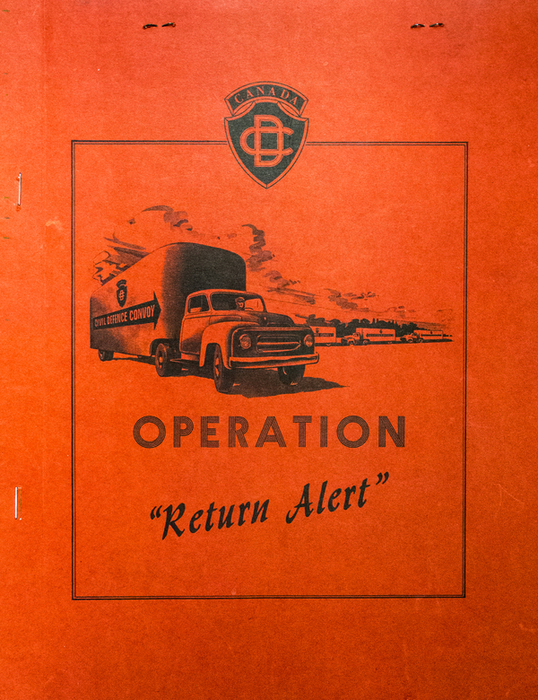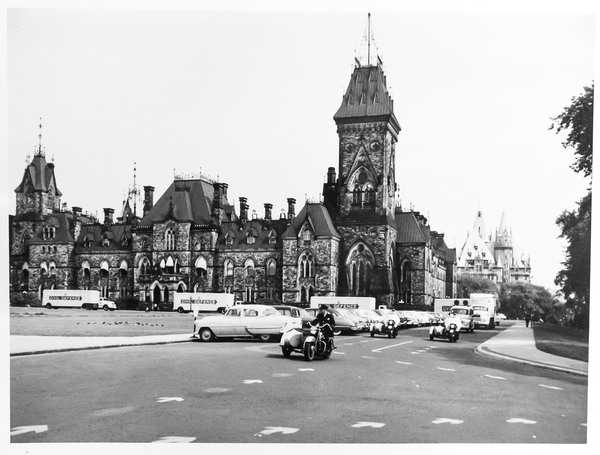"Selling" Civil Defence
In the early 1950’s, the Internal Services Division (ISD) of the Department of National Health and Welfare was tasked with the development of publicity campaigns that could recruit volunteers into civil defence roles.[11] Sidney Denman, an advertising representative from Montreal, was hired to help “sell” civil defence to the Canadian masses.[12] In the early days of mass communication, partnerships between governments and advertising firms were not uncommon.[13] During World War II, for example, the United States government partnered with the Advertising Council, a group of communications agencies formed to consult on the development of propaganda campaigns.[14] It was this Council that developed propaganda campaigns for the US Federal Civil Defense Administration during the Cold War.[15] In Canada, the ISD worked with the executive of the Canadian Advertising and Sales Clubs to solicit their assistance in publicizing civil defence across Canada.[16] Beginning with a representative to the government Advisory Committee on civil defence in the spring of 1955, this collaboration soon progressed to the responsibility for organizing local community publicity campaigns aimed at civil defence recruitment and training.[17]
Canada’s civil defence publicity campaign was well underway by late 1951[18], spearheaded by a new brand and distinctive logo - the letters “C” and “D” stylized onto a badge in the shape of a shield, topped by a “Canada” banner [Figure 4]. The Internal Services Division (ISD) established a public presence by exhibiting messaging at various events such as the 1952 Canadian National Sportsmen’s Show in Toronto. These exhibits were visually attention-grabbing, often depicting the threat of nuclear war via the ubiquitous mushroom cloud placed cannily over a city skyline.[19] But limited federal funding stymied the development of a nation-wide Canadian-made campaign,[20] and so the ISD adapted an American model - Alert America - to the local context. Alert America was essentially a travelling educational road show intended to convince the public of their crucial role in war-time civil defence. Each Alert America convoy consisted of ten 30-foot tractor-trailers containing a variety of eye-catching exhibits showcasing the consequences of atomic war, as well as didactic instructions for preparedness. Frank Worthington, Federal Civil Defence Coordinator for Canada, recognized an opportunity to repurpose the American exhibition for audiences north of the border. Destined for eleven Canadian cities across the country the convoy was launched from in front of the Parliament buildings in Ottawa on September 19, 1953[21]. [Figure 5].
In each of its national destinations - cities chosen for their potential as targets of nuclear attack - the On Guard, Canada travelling convoy aimed to educate Canadians on the responsibilities of civil defence, using visual communication as a tool of persuasion. Given the costs of this tour, it was not repeated, and the ISD again turned to platforms of mass communication such as instructional pamphlets and propaganda posters, cheaply produced items that could be distributed through existing channels with the press and media organizations.[22]
References
11 Andrew Burtch, “Armageddon on Tour: The "On Guard, Canada!" Civil Defence Convoy and Responsible Citizenship in the Early Cold War,” International Journal 61, no. 3 (2006): 735-756..
12 Burtch, Give Me Shelter, 60.
13 Jonathan Rose, “Government Advertising and the Creation of National Myths: The Canadian Case,” International Journal of Nonprofit and Voluntary Sector Marketing 8, no. 2 (2003): 153-165. DOI: 10.1002/nvsm.209.
14 Inger L. Stole, Advertising at War: Business, Consumers, and Government in The 1940s (Chicago: University of Illinois Press, 2012).
15 McEnaney, 35.
16 H.W. Adams, Director, Information Services Division to F. Dostie. December 27, 1955. LAC RG 29, Vol. 102, File 180-8-1
17 Ibid.
18 Burtch, 60.
19 Ibid., 60-61
20 Ibid., 61.
21 F.F. Worthington letter to Provincial Civil Defence Co-ordinators, July 23, 1953. LAC Group 29, Vol. 56, 100-5-13
22 Burtch, 61.

